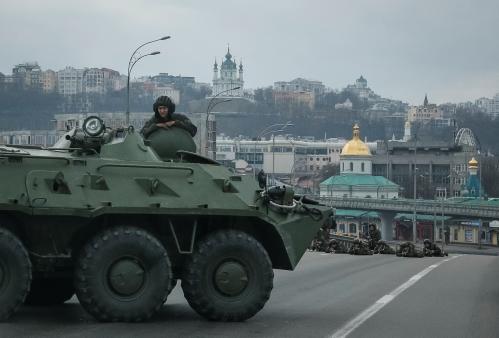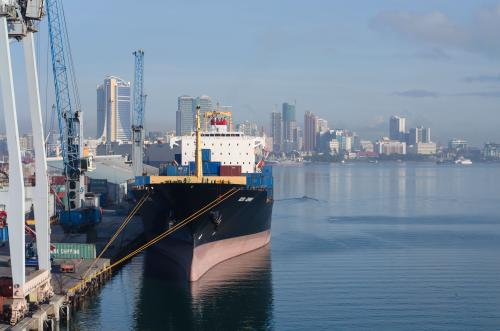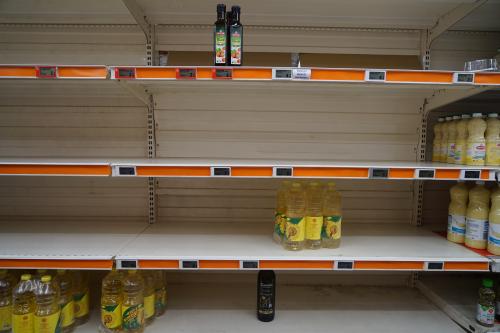Through social media outlets like Facebook, Twitter, TikTok, and YouTube, many around the world have been following the unfolding havoc wreaked on Ukraine by Russia. Ukrainians have been able to effectively utilize these platforms to show the atrocities of war in real time, raise funds, and rally support from the international community, but face challenges posed by Russia’s attempts to obscure facts through disinformation, misinformation, and propaganda.
In fact, these campaigns serve to create divisions, sow distrust, and pivot the conversation to other issues that cloud judgement and weaken the collective response of Ukrainian allies. Notably, any delay in response might have devastating consequences, as Ukraine is in dire need of everything from weapons and medical supplies to political and moral support.
The information spaces in Africa and other regions of the Global South like India and China have been heavily targeted by Russian disinformation and propaganda campaigns in recent months and years. In the case of Africa at this moment, Russia’s objectives are not only to justify its invasion of Ukraine, but to sway African countries to support Russia’s actions and secure Russia’s influence over the region, especially as the country becomes increasingly isolated from the United States and Europe.
Africa has economic and political ties with both Russia and the European Union and seems to be caught in the middle of this conflict as demonstrated by the divided African vote for the UN resolution condemning Russia’s invasion of Ukraine. The war and Russian control of Ukrainian land and sea exacerbate energy, fertilizer, and food insecurities within the African continent. At the same time, Europe’s pivot away from Russian imports of gas and oil serve as an opportunity for African nations to substitute those supplies and generate much-needed revenue.
Given the importance of Africa’s partnership and cooperation with Ukraine and the EU, it is crucial to track the pervasiveness of Russian narratives and online disinformation that aim to dissuade such coalescence. We can begin to peer through the fog of information pollution by analyzing Twitter data of users in Africa or discussing Africa in the context of the Russia-Ukraine war to gain insights into which Russian narratives and disinformation topics are most widely spread, how they evolve over time, and who has the most input in the conversation.
For this two-part series, we analyzed over 2.5 million of such tweets between February 14 to June 9, 2022 (nonconsecutive) that discuss Ukraine and/or Russia. In this first part of the series, we examine the broader Russian narratives that continue to proliferate throughout the African continent. In the second part, we will focus on specific disinformation topics resulting from Russia’s brazen invasion of Ukraine (see the bottom of this blog for a note on our methodology).
Russian narratives exploit existing tensions and grievances
Sentiments in Africa concerning the crisis vary dramatically in the tweets. While many Africans stood (and continue to stand) in solidarity with Ukraine, a significant portion of the relevant discussions trending online initially focused on African students fleeing Ukraine and the racism they faced.
In the first two weeks of the war (through March 9), the most-tweeted Russian narrative (over 178,000 tweets) concerning the war claim that all Ukrainians and Europeans—but not Russians—are racist. For example, some of these tweets accuse the EU of instructing Ukraine not to let African students escape. Other narratives include more general anti-West rhetoric. Many of these tweets allude to past conflicts, particularly in Libya and Afghanistan, and how the world ignored conflicts in Africa and the Middle East. Other tweets go to a somewhat more extreme direction, calling the EU and U.S. “economic bandits” or stating that Russia does not have a history of slavery and colonialism while Europe does (spoiler alert: Russia has a long history of subjugation and imperialism). Another popular claim is that the war would have been avoided if NATO met Russia’s security concerns, even though Vladimir Putin made it clear in the past and more recently that his goal is to return to an imperial Russia.
While these narratives take the focus away from the war in Ukraine, they contain legitimate concerns of food insecurity and uncomfortable truths, like the selective outrage of the West that undermines their partnership with African nations.
Over 105,000 tweets employ “whataboutism,” where users avert the conversation to other topics, disregard the crisis, reject criticism of Russia’s actions and political influence, or proclaim hypocrisy. These tweets often discuss conflicts going on in other parts of the world—particularly in Yemen, Syria, and Ethiopia—or how domestic issues in countries like Nigeria are far more dire than in Ukraine. The general sentiment is that “Ukrainian lives are worth more than others.” Certain tweets specifically mention the blocked humanitarian aid to the Tigray region and the emergency UN General Assembly meeting that was called upon for the war in Ukraine, but not for other wars and conflicts.
Tweets employing whataboutism are growing
As the war continued through the beginning of June, the focus on racism decreased substantially, with 17,000 tweets discussing the racism fleeing African students faced. Over 122,000 tweets contain general anti-West rhetoric—with some users acknowledging that the security concerns that Russia is using to justify the invasion are part of “Putin’s propaganda,” but that Western media has pushed its own propaganda in cases like Ethiopia as well as in conflicts in Libya and Afghanistan. By far, whataboutism is now the most popular strategy used within the discussions with over 198,000 tweets. A significant number of these tweets also focus on the weaponization of food supplies and how the attention remains on Ukraine while Africans face daily food shortages that will only intensify. Those tweets focus on Tigray region of Ethiopia and the conflict in Somalia, highlighting selective outrage or mobilization of the international community and media (e.g., chiding users with a Ukrainian flag emoji in their profiles to react with the same intensity to crises in Africa).
Beyond text, hashtags and emojis serve as powerful tools for expressing opinions and emotions to events. Further analysis of hashtags used in tweets discussing racism prominently feature #africansinukraine, #racisteu, and #blacklivesmatter. Hashtag usage in tweets with more general anti-West rhetoric feature hashtags like #nato and #eu but also others like #istandwithputin, #istandwithrussia, #hypocrisy, and #abolishnato. The hashtag usage of whataboutism tweets feature #ethiopia, #tigraygenocide, #somalia, #freemazinnamdikanu, #biafrareferendum, and many other hashtags concerning issues that do not relate to the Russian invasion of Ukraine. The following and more can be seen in Figure 1 below, which shows the top 200 hashtags used in the 2.5 million tweet collection examined.
Figure 1. Hashtags used in response to Russia’s war in Ukraine within Africa
Source: Authors’ calculations.
Who drives the discussion?
Since retweets comprise the majority of content on Twitter about Ukraine, one way to examine who steers the conversation is by looking at the top 100 most retweeted accounts. In the first two weeks of the invasion, general users and activists comprised the largest share of the top retweeted accounts across all three of the narratives—media outlets and journalists (mostly independent) followed.
State-affiliated Russia Today was among the most retweeted platforms for tweets with whataboutism and anti-West rhetoric, both in the beginning of the invasion and more recently. Russian government accounts, like the Russian Embassy of South Africa and the Russian Ministry of Foreign Affairs, also play prominent roles in these discussions.
Notably, February 2022 (specifically the first two weeks of the war) saw the largest number of newly created accounts in tweets and retweets generated in that time period—a 190 percent increase compared to the average new accounts per month in the previous year (Jan 2021-Jan 2022). The greatest number of individual accounts made in a single day occurred on February 24, evidently the start of Russia’s full-scale invasion. Such spikes in new accounts are seen in other studies, which have been suspected to be bot networks amplifying Russian-affiliated tweets.
The continuing perpetuation of these narratives demonstrate why we must pay close attention to the sentiments, rightly or wrongly, that African users on these online platforms hold. While these narratives take the focus away from the war in Ukraine, they contain legitimate concerns of food insecurity and uncomfortable truths, like the selective outrage of the West that undermines partnerships with African nations. The disinformation topics to be discussed in the following post are far less grounded in reality and contain everything from Nazis to bioweapons to complete confidence that the war in Ukraine is … you guessed it, a staged cover-up for Hunter Biden.
Note on methodology: Over 60 million tweets were compiled using an open-source command line tool known as Twarc, which archives tweets that contain a specific qualifying term—in this case, any tweet containing the word or hashtag “ukraine” “ukrainian” “russia” “russian,” and their variations, from February 14 to March 14, and April 26 to June 9, 2022. Then, a subcollection was made of users who specified they were in Africa using the self-identified “location” in the user’s profile or discussed Africa within the text of a tweet.
The then-smaller collection of 2.5 million tweets was sorted; tweets corresponding to a specific narrative were grouped together into “clusters.” Tweets that did not fit into a topic were dropped for the purposes of this analysis. Each tweet contains more than 150 different data variables, but for the analysis shown here, we focus on the time when the tweets was created, location of the user, when the account of the user was created, the user’s bio, the full text of the tweet or retweet, and who originally generated the tweet. Hashtag and emoji usage were extracted from the full text of the tweet, the emojis were converted from Unicode to their written-out names, and the hashtags were formatted to account for inconsistencies in spelling and capitalization.









Commentary
Russia’s narratives about its invasion of Ukraine are lingering in Africa
June 27, 2022